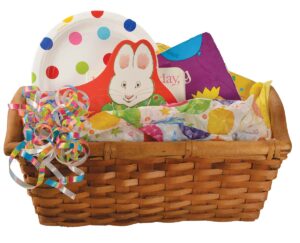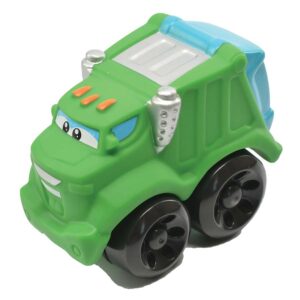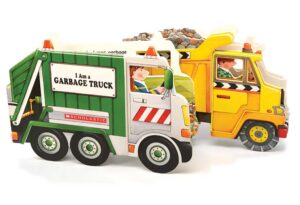Receptive language, Expressive language, Awareness of print and pictures
A toddler contributes to a shared book reading session by holding and managing the book.

All the World by Liz Garton


Social-Emotional
Invite a toddler to sit next to you to share a story. Show the toddler the cover of the book and point to and describe images on the cover, especially the two children and the path/road. Explain, “Our book is called All the World. It was written by a person whose name is Liz Garton.”
 Open the book and begin to read the text. Use your own playful words to describe some of the pictures. Also, as you read the book, point to a picture and ask the toddler what he/she sees. Emphasize words that rhyme and words that repeat.
Open the book and begin to read the text. Use your own playful words to describe some of the pictures. Also, as you read the book, point to a picture and ask the toddler what he/she sees. Emphasize words that rhyme and words that repeat.
Pause while reading to respond to the toddler’s comments or actions, such as pointing to a picture.
During or at the conclusion of the book sharing, ask the toddler if he/she would like to hold the book. Place the book on the toddler’s lap and, if it appears necessary, show him/her how to turn one page.
Point to details in some of the pictures, and encourage the toddler to point. Examples: “The truck is on the road.” “The children are playing by the water.”
Encourage the toddler to:
At the end of the session, offer some highlights of the exchange, including the toddler’s role in holding and managing the book. Examples: “Our book is about people working and having fun outside.” “You helped us read the book together by holding the book and turning the pages.” “You pointed to pictures and talked about what you saw.” “You liked the picture of the girl in the tree.”
If the toddler closes the book before it ends, ask if he/she is “all done” with this book. Encourage the toddler to select another book from the basket or display. Talk about the picture on the cover and say the name of the book. Continue with the book the toddler chose.
If a toddler points to a picture and says, “What is that?” briefly describe the illustration in your own words. Example: “The kids are digging in the sand.” Pause for the toddler to respond.
If a toddler brings you a book he/she read the day before, simply comment, “You like this book. Let’s read it again.”
Toddlers will begin to develop interest in books when they are shared daily and in an enthusiastic way. Help toddlers recognize there are books about topics they enjoy.
Extra support
Enrichment
Receptive language, Expressive language, Awareness of print and pictures
Toddlers practice holding and managing books they select and look at as part of planning and preparing for a pretend party.



Be Prepared: Arrange the dramatic play center for a pretend party. Gather books suggested in the Materials Needed list and secure other books about baking or parties. Place the books in a basket.
Invite four toddlers to the dramatic play center to make plans for a pretend party. Sit on the floor facing the toddlers and talk with them about what children do at a party. Explain that we can plan a party together by looking at books for ideas about what to eat and do at a party. Draw attention to the books in the basket. Describe what several of the books are about. Point to a book’s pictures and explain that the pictures show what we might eat or do at the party.
Encourage each child to select one book from the basket and look at the pictures. Some toddlers may want to look at a book together. Draw attention to pictures of baking or sharing food.
Demonstrate and describe how to hold a book and turn the pages of a book. Provide specific guidance to toddlers on how to hold a book on their laps and turn pages. Remind toddlers that we are using the books to get ideas for a party.
Encourage toddlers to share books with each other. Example: “Each of us should look at more than one book. Different books will give us different ideas.”
Encourage the toddlers to talk about what they saw in the books that they want to use in the pretend party. Also encourage active participation in preparing the dramatic play area for a party. Help the toddlers take turns talking. Facilitate sharing and turn taking. Refer to the books and revisit pictures you noticed toddlers looking at. Example: “I saw Tanya looking at this book about how to make cookies. Look at this picture of cookies! Will cookies like these be part of the party?”
Look for instances of a toddler holding a book upside down and/or not turning pages of a book. Quietly provide support for appropriate use, including page turning. Some toddlers will be more comfortable standing with a book on a low surface than sitting with a book.
If a toddler shows no interest in the party theme of the book-focused first segment of the activity, help him/her find a different book to explore. It is fine if a toddler wants to bring a favorite book from another area. The party theme is secondary to the goal of promoting skill in holding a book and turning its pages. A toddler who does not want to look at party (or food-related) books may be interested in a role in the activity’s second segment focused on party preparations, such as putting plates on the table or taking pictures of friends with the toy camera. You may be able to refer to a book picture related to the child’s contributions to party preparations.
Extra support
Enrichment
Receptive language, Expressive language, Awareness of print and pictures
Toddlers practice using books they select and look at as part of play with toy trucks and cars.



Be Prepared: Gather the books listed in Materials Needed and secure additional books related to vehicles. Place some of the books in a basket in the building center, and arrange several books on the shelf with toy cars and trucks. Be familiar with the content of the books, especially illustrations, so you can help toddlers connect a book (or a book picture) to their construction work.
[Invite several toddlers to the building center for an informal gathering. Sit facing toddlers and welcome each one.]
Today we have some special time for using blocks and trucks. We have big cardboard building bricks and big cars and trucks. We also have books about cars and trucks.
[Draw attention to the basket of books.]
You may build whatever you like and use toys from the shelf.
[Encourage the toddlers to get blocks and vehicles they want to use. Remain on the floor with the toddlers to observe their building and truck play, and to talk with them about their ideas.
 Identify books that relate to the toddlers’ building ideas, such as dumping trash, building a road, or arranging cars. Example: “Sam, I see you are using cubes in the dump truck and pretending you are the garbage truck driver. Here is a book about a garbage truck. Would you like to look at it with me?”
Identify books that relate to the toddlers’ building ideas, such as dumping trash, building a road, or arranging cars. Example: “Sam, I see you are using cubes in the dump truck and pretending you are the garbage truck driver. Here is a book about a garbage truck. Would you like to look at it with me?”
If a toddler shows interest in a book, move close to the child to look at the pictures with him/her. Turn the book so the cover is showing. Encourage the toddler to hold the book on his/her lap and open it to the first page.
 When you share a book with a toddler, help the toddler take the lead in looking at pictures and turning pages. Offer guidance about how to use the book. Example: if the toddler has the book upside down, explain that it is easier to see the pictures if we turn the book.
When you share a book with a toddler, help the toddler take the lead in looking at pictures and turning pages. Offer guidance about how to use the book. Example: if the toddler has the book upside down, explain that it is easier to see the pictures if we turn the book.
If the toddler turns several pages at once, wait for a good opportunity to explain page turning. Example: “We can feel the pages with our fingers. There are more pictures to see. Our book has pictures on every page.”
Point to available text (even if it is one word) as you look at a book picture with a toddler. Explain the use of words. Example: “These words say the red truck is loaded with wood for building houses.”
If a toddler finds one picture especially interesting, encourage the toddler to point to details and talk about it. Offer comments and ask questions. Examples: “I see this little truck is loaded with corn.” “Do you see the big truck?” “What other things do trucks carry?”
If a toddler does not refer to one of the books in the building area, look for one that may be of interest to the child. Show interest in the toddler’s building and a related book. Example: “James, this has pictures of roads going through tunnels. I will take it out of the basket so you can look at it when you are ready.”
Assist toddlers in putting books away.]
[Offer highlights of how toddlers looked at books as part of building roads and buildings for trucks.]
Your role of helping connect a toddler with a pertinent book requires close monitoring of each toddler’s efforts and interests. Offer books or point out book illustrations that seem pertinent to what a child is doing in the activity. Avoid insisting on their use of the books. For some toddlers, it may be too challenging to briefly consult a book and build at the same time.
If a toddler is new to using blocks with other children, talk aloud about a block center idea (such as making a road). Help a toddler get started building by inviting him/her to build with you. As he/she becomes active in building with you, stay close and shift your role to an observer.
At this age, toddlers are not expected to articulate a detailed plan for block building, but talking with a child before, during, and/or after the activity can reinforce his/her cognitive skills in thinking about a plan.
Extra support
Enrichment
To promote scribbling or beginning marks of letters, provide paper on clipboards or 5”x7” cards and markers for toddlers to make signs for their buildings or small traffic signs for their roads.
Materials Needed: books on topics of interest to children
Display books in all areas of the room. Arrange books on the book display so all covers are showing, and the books are right-side up. Model and demonstrate how to handle books. Provide baskets for related books. Example: put several books about going to sleep in one basket and books about pets in a separate basket. Rotate books regularly, leaving the favorites. Encourage toddlers to sit with you and hold one book on their lap. Make book time a regular part of the daily routine. Make sure every child has a one-to-one book experience with a staff member daily.
Materials Needed: A Box Can Be Many Things by Dana Meachen Rau, Anna Hibiscus by Atinuke, Mr. Cookie Baker by Monica Wellington, Sleepyheads by Sandra J. Howatt, The Little Red Hen by Diane Muldrow
Provide books for children of all ages. Infants will enjoy cloth books with bright pictures. Toddlers should have a variety of board books with clear illustrations and books with photographs of real objects, people, and animals, along with books about subjects they understand. Sleepyheads by Sandra J. Howatt is a calming book about resting.
Preschool children will enjoy picture books about real and make-believe subjects. Text should be printed clearly across a page in a line to help children begin to associate reading with lines of letters and words. Mr. Cookie Baker by Monica Wellington shows the steps in making cookies. The Little Red Hen by Diane Muldrow is a fun book with repeated phrases.